Anarko on Nostr: 🌊 SURF 'N TURF 🏝️ -THE BITCOIN BORACAY ISLAND LIFE- ...
🌊 SURF 'N TURF 🏝️
-THE BITCOIN BORACAY ISLAND LIFE-
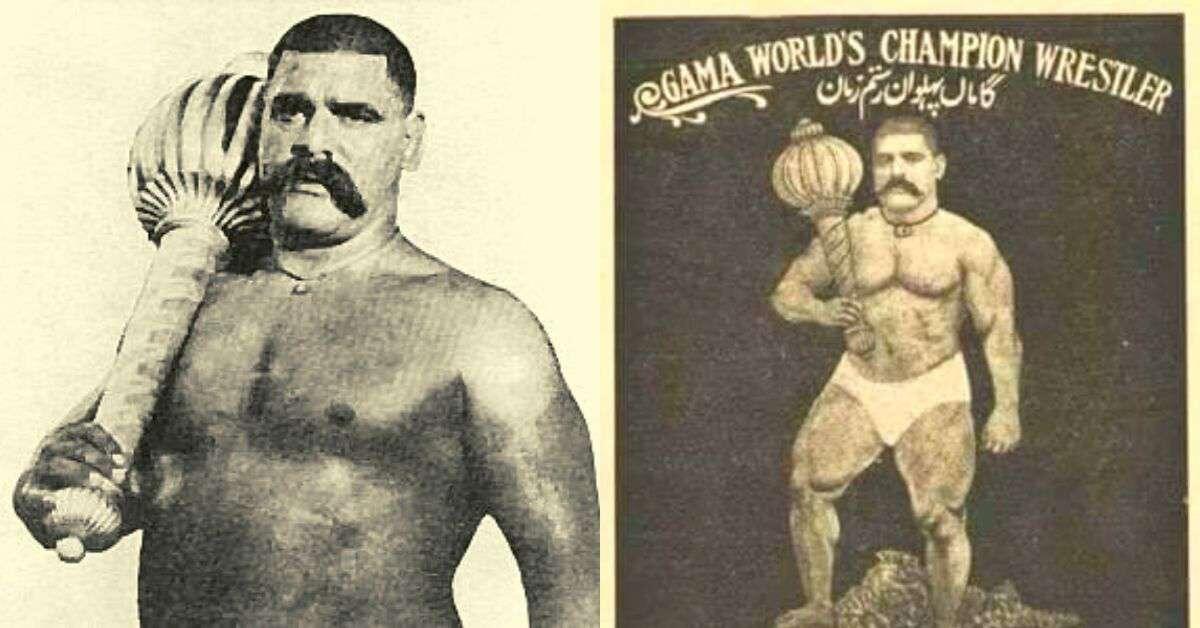
The World Champion Pehlwan Who Inspired Bruce Lee & Saved Lives During Partition.
In a wrestling career spanning five decades in the early 20th century, Ghulam Mohammad Baksh Butt, popularly known as The Great Gama or Gama Pehlwan, remained undefeated.
By Rinchen Norbu Wangchuk
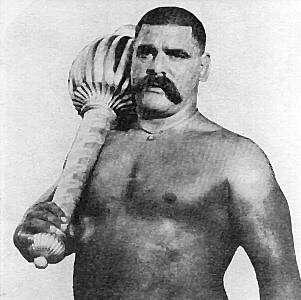
The World Champion Pehlwan Who Inspired Bruce Lee & Saved Lives During Partition
Ghulam Mohammad Baksh Butt, popularly known as The Great Gama or Gama Pehlwan, was a practitioner of pehlwani wrestling (a form of South Asian wrestling also known as Kushti) who became the champion of India (Rustam-e-Hind) and the world in the early 20th century.
(Images above courtesy Wikimedia Commons and Twitter/Md Umar Ashraf)
https://youtu.be/kPlMFbBV264
Remaining undefeated in a remarkable career that spanned around five decades, he would go on to inspire countless in the Indian subcontinent during the freedom struggle and even the legendary martial artist and actor Bruce Lee.
From a Kashmiri Muslim family living in the erstwhile province of Punjab, Gama stayed back in Pakistan during Partition. During this bloody episode, however, he also went on to save many Hindus from bloodthirsty mobs.
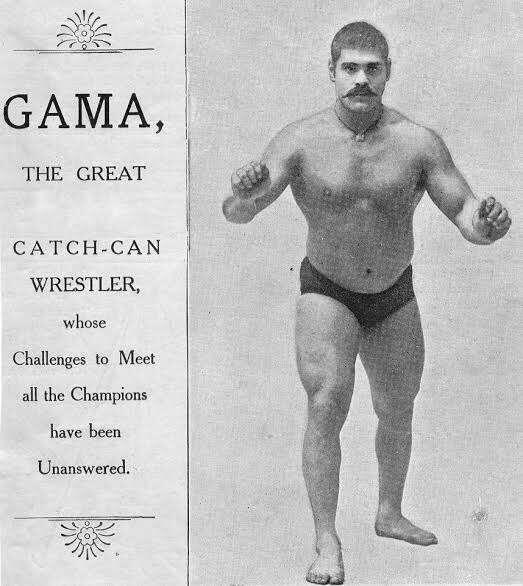
By any stretch of the imagination, he led a remarkable life.
Making a Mark
Born on 22 May 1878 in Jabbowal village in Kapurthala district, wrestling was an integral part of the family identity. His father Muhammad Aziz Baksh, for example, was a court wrestler who fought under the patronage of Maharaja Bhawani Singh of Datia.
Unfortunately, he was barely six, when his father passed away but not before instilling in a young Gama the desire to become the world’s greatest pehlwan (wrestler).
https://youtu.be/KhsRRm1eNZk
Following his father’s death, both Gama and his younger brother were initially taken in by their maternal grandfather Nun Pehlwan. Eventually, their maternal uncle Ida Pehlwan took over the responsibility of raising the two young boys.
As a December 2016 feature article by Sagnik Kundu in Sportskeeda notes, “It was Ida who vowed to transform Gama into a champion pehlwan, something that Aziz had already envisioned. It was the catharsis of this quest that would spur Gama through the rest of his life.”
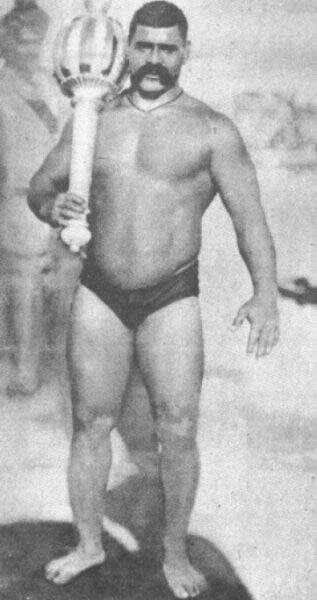
He made his mark as a 10-year-old during a competition organised by the Maharaja of Jodhpur measuring who could do the most ‘bethaks’ (deep knee bends/squats). Attended by around 400 contestants, it was a tightly contested affair given how these bethaks were a common training exercise for wrestlers. Remarkably, the young boy was among the last 15 participants left standing but the effort expended during the competition left him bed-ridden for a week.
Wrestler Gama Pehlwan
Gama Pehlwan doing his exercises (Image courtesy Wikimedia Commons)
However, this achievement caught the attention of wrestling aficionados, and soon invitations came flying in for the young boy to compete in competitions across India. Thanks to his uncle’s guidance, however, he began wrestling competitively by the age of 15. “Mind you, none of this was achieved in a day. Gama had a strict regime from a very early age including 500 bethaks, 500 dands or ‘jack-knifing push ups’, and the regular pit-digging every single day. He followed a diet of milk, fruits and almonds. When he was 15, meat, butter, yakhni (a boiled down gelatinous extract of bones), joints and tendons were incorporated into his diet,” notes Sagnik.
Like his father, Gama also became a court wrestler in the Maharaja of Datia’s court with a training regimen that “now included 3,000 bethaks and 1,500 dands every day” while running a mile with a 120-pound stone ring tied around his neck. The royal patronage he received also allowed him to take in “a daily diet of about ten litres of milk, half a litre of ghi [ghee], a litre and a half of butter, and two kilograms of fruit,” according to American anthropologist Joseph S Alter, who wrote a book ‘The Wrestler’s Body: Identity and Ideology in North India’.
Becoming A World Champion
His wrestling career was going so well that at age 19, he challenged Raheem Baksh Sultani Wala, the Indian wrestling champion. Barely 5’8″ (or 5 feet 9 inches, according to some accounts), many thought this was a ridiculous challenge given how Raheem stood at a towering 6’9″ not to mention his ability in the ring. No one gave Gama any chance of winning, and many analysts at the time predicted that Raheem would destroy the young upstart.
But much to the disbelief of many in the crowd, a young Gama battled Raheem for hours and somehow scraped a draw. In the rematch, the outcome was the same leaving both of them battered. By 1910, which was two years before he became a court wrestler of the Maharaja of Patiala, Gama had beaten all the famous Indian wrestlers except Raheem.
This was around the time when the Indian freedom struggle really began to kick off. In the same year (1910), Gama was sent to London to compete in the John Bull World Championship, along with his brother and two other wrestlers with sponsorship coming from Sarat Kumar Mitra, a Bengali millionnaire. Unfortunately, Gama was considered too short to officially compete by the officials organising this competition. Despite his deep disappointment, Gama was offered £250 a week to participate in a series of sideshow bouts at a local theatre in London.
There is another version of why he wasn’t allowed to compete. In a 2014 conversation with HT, Ratan Patodi, the editor of the Bharatiya Kushti Patrika, said, “Once he reached London, weighing just 88 kilos, Gama realised he couldn’t qualify for a championship that allowed only heavyweights. So, his manager decided to throw an outrageous challenge.”
At this unofficial venue, Gama Pehlwan would challenge any wrestler in London for a bout. Whoever could last five minutes in the ring with Gama was promised £5. In the first two days, he would go on to dispatch about 15 English challengers. As word went around, others came to challenge him. He would go on to beat the American champion Benjamin Roller in less than 3 minutes and defeat around 30 Japanese wrestlers, according to certain accounts.
Given how he was dismantling everyone who took up his challenge, the organisers of the John Bull World Championship had no choice but to give him access to the official tournament where he was pitted against the world champion Stanislaus Zbyszko of Poland.
“Though much smaller in size, Gama fought Zbyszko for three hours and clearly had the upper hand when the contest ended for the day. Zbyszko failed to show up the following day to continue the bout and Gama was declared the world champion. The symbolic implications of Gama’s rout of England’s best wrestlers in the very seat of imperial power were not lost on the subjugated Indian public. Popular accounts have it that there was not a single newspaper in Hindi or Urdu that did not herald the news of India’s triumph,” notes Joseph Alter.
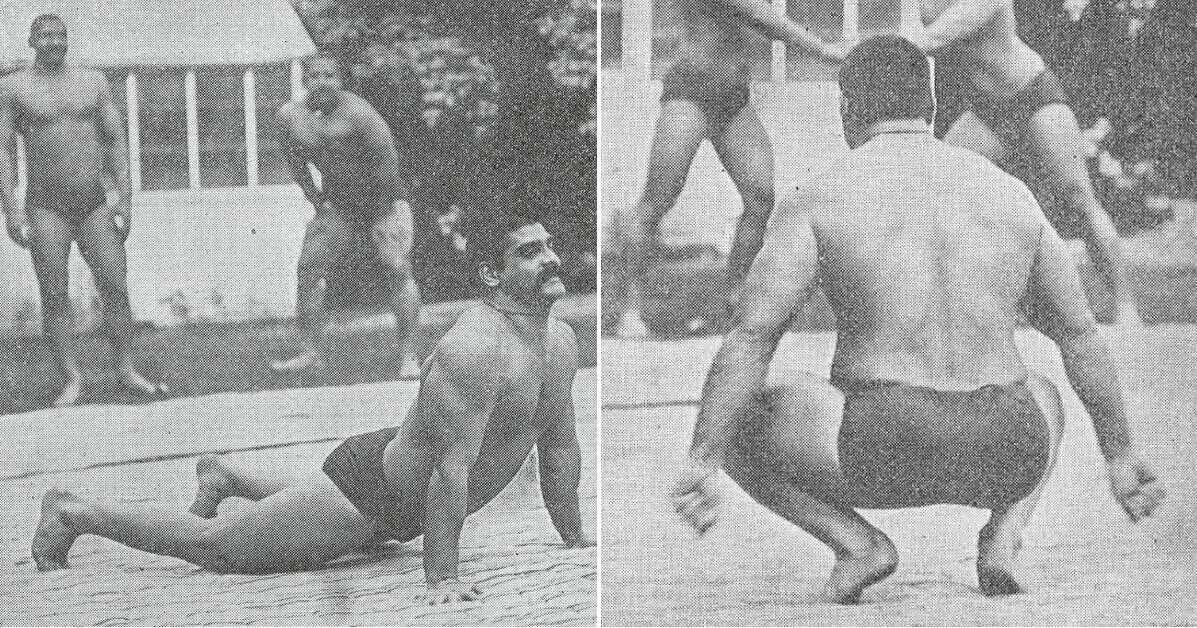
Gama Pehlwan (Image courtesy Twitter/Md Umar Ashraf)
Champion of India
Interestingly, Gama won the world championship before becoming a national champion. Following his return to India, he once again called out Raheem for a bout. Two years after his win in London, Gama and Raheem fought each other in front of a crowd of 50,000 in Allahabad.
Many rank this among the most famous wrestling bouts in the history of the Indian subcontinent. This time Gama Pehlwan defeated Raheem and earned the title ‘Rustam-e-Hind’ or ‘Champion of India’.
It would be 16 years later when his next major bout would come. At the behest of the Maharaja of Patiala, where he had already been a court wrestler for 16 years, Gama challenged Zbyszko once again. In front of a crowd of 1 lakh, a 50-year-old Gama dismantled Zbyszko in barely 42 seconds. It was an incredibly one-sided affair in Patiala.
As Alter notes in his book, “After the victory, the Maharaja embraced Gama, took the pearl necklace he was wearing, and placed it around the champion’s neck. A parade was arranged and Gama rode on the king’s elephant holding in his arms a silver mace made especially for the occasion. So that Gama’s regal achievement would not be forgotten, the king gave him a whole village and an annual stipend of 6,000 rupees. One can well imagine the prestige that the Maharaja of Patiala derived from this contest. As the wrestling euphemism for defeat goes, the maharaja had ‘shown the world the sky’ by pinning down an emblem of imperialism. Gama and his patron came to symbolize the possibility of self-determination and independence.”
However, other accounts claim that Gama Pehlwan refused to board the king’s elephant and instead chose to walk alongside his fans, who formed a procession celebrating the win. His last meaningful professional bout came the following year when he defeated Swedish wrestler Jesse Peterson.
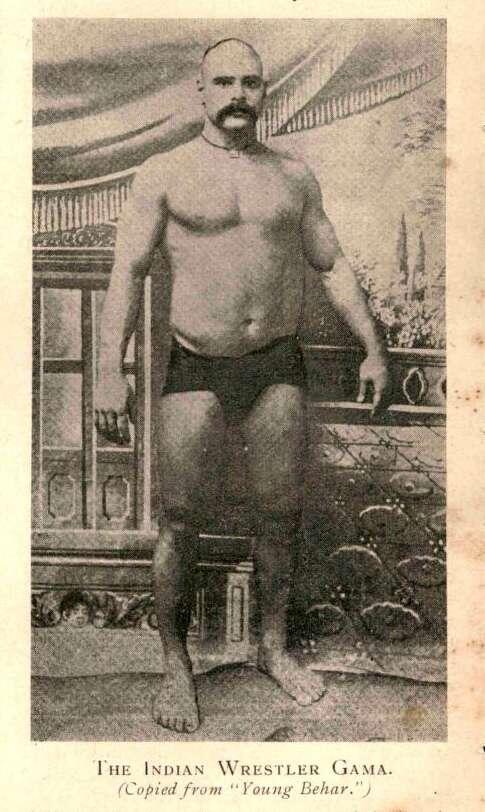
Bloody Partition
Before the Partition was announced, Gama lived in Amritsar. Sadly, the rising communal poison had vitiated the atmosphere in the city to such an extent that he shifted to Lahore, a city where he fought many bouts, in early 1947. Settling in a colony with Hindu families, he vowed to protect them from the violent mobs. Sometime in April-May 1947, Gama and his fellow wrestlers saved them from the mobs armed with axes and swords. But as the situation got worse, Gama realised that living in Lahore was no longer safe for these families. Bearing all the expenses, Gama escorted the Hindu families from his colony to the border where he bid adieu to them.

Sadly, however, Gama Pehlwan spent the last few years of his life in dire financial conditions with little to no support from the Pakistani government. He passed away in 1960 at the age of 82. The stories of his exploits are still told today in the taleems of Kolhapur and akharas of Haryana. As stated earlier, even Bruce Lee incorporated some of Gama’s exercises like the bethak and the push-ups into his training regime after reading articles about the legendary wrestler.
There is little doubt that Gama was a true champion whose legacy must never be forgotten.
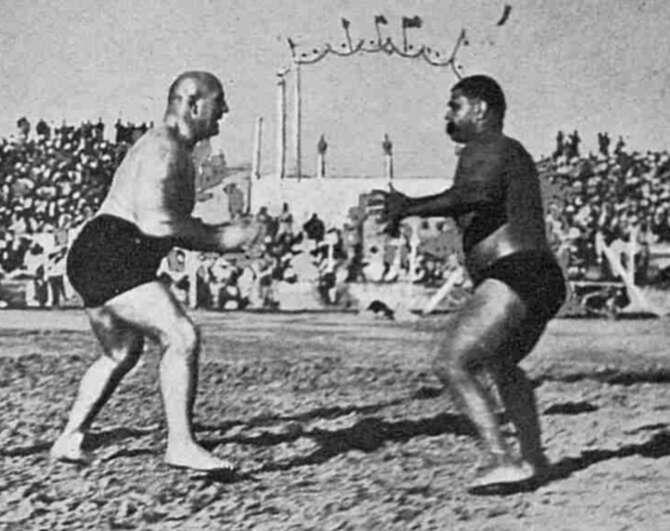
Sources:
‘The Wrestler’s Body: Identity and Ideology in North India’ by Joseph S. Alter (University of California Press, 1992)
‘The Great Gama – The pehelwan who refused to lose’ by Sagnik Kundu/Sportskeeda (23 December 2016)
‘Here’s The Story Of Gama ‘The Undefeated’ Pehalwan And How He Saved Hindus During 1947 Riots’ courtesy Indiatimes (16 May 2017)
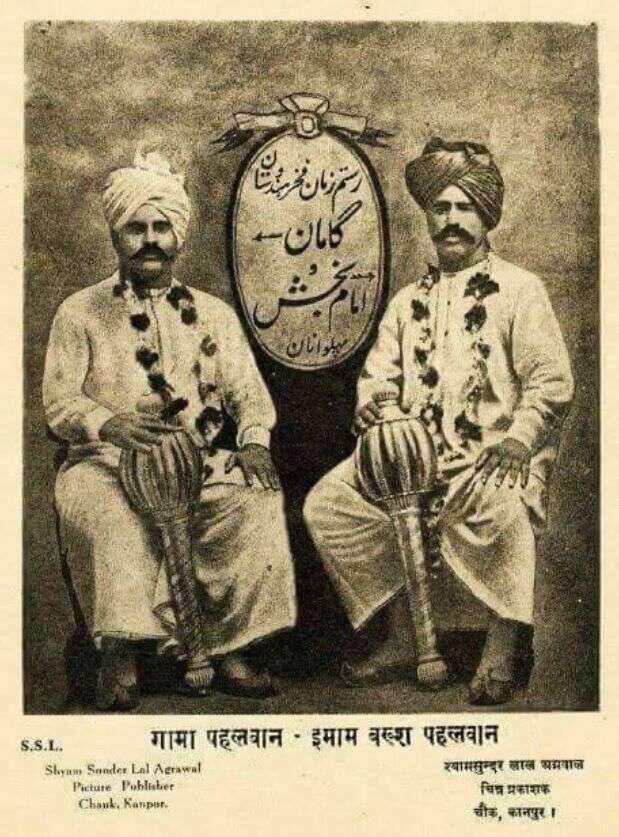
(Edited by Yoshita Rao)
Credits Goes to the respective
Author ✍️/ Photographer📸
🐇 🕳️
#Bitcoin #Freedom #Apocalypse #Music #Movies #Philosophy #Literature #dogstr #islands #scuba #marinelife #architecture
